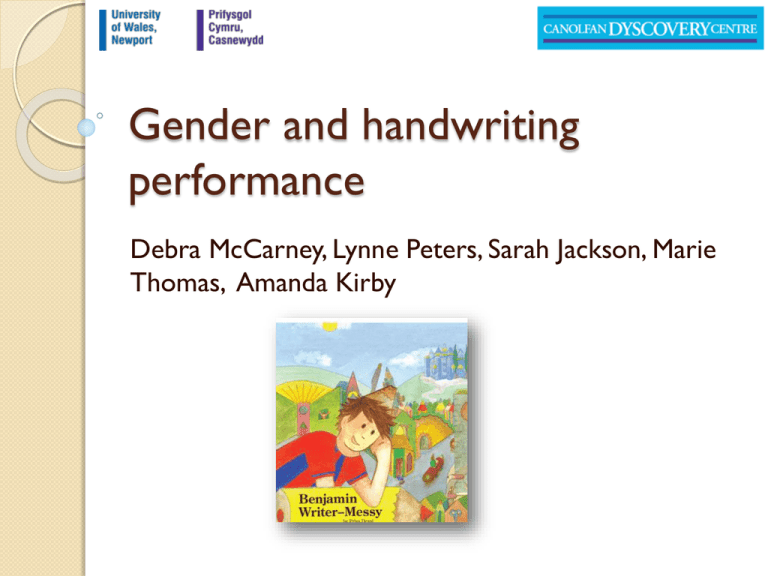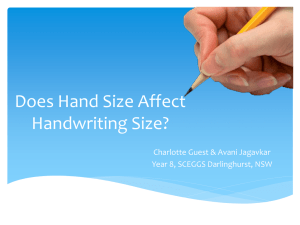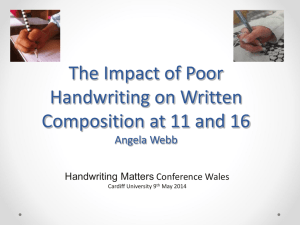The relationship between gender and handwriting performance
advertisement

Gender and handwriting performance Debra McCarney, Lynne Peters, Sarah Jackson, Marie Thomas, Amanda Kirby Background to the study Internal and external factors potentially affecting development of writing skills in primary aged children ◦ Motor development ◦ Literacy / language development ◦ Gender stereotypes and differences Motor development “Several authors have suggested that difficulty in the mastery of the mechanical aspects of handwriting may interfere with higher order processes required for the composition of text” (Rosenblum, Weiss & Parush, 2003) Fluency in handwriting – “the single best predictor of length and quality of written composition” (Medwell & Wray, 2008) Literacy and language development Conflicting research on early ability - Stromquist (2007) – little difference in literacy ability between boys and girls of kindergarten age Boys have weaker early literacy skills when they enter school and this persists or increases during primary years (Below et al, 2010) Gender stereotypes… “The boys commented that in general they had tried to make their writing smaller and neater. The girls, in contrast, said almost unanimously that they had made their handwriting larger, and half of them said they had made it less tidy, or more scruffy.” Hartley, 1991 “... children discover early, aided by the influence of peers, that one book is a ‘girl book’ and another a ‘boy book’ ” Merisuo-Storm, 2006 Francis and Skelton (2005) call for “a deconstruction of masculinity and femininity so that girls and boys do not see aspects of learning as gendered” Children’s stereotypes about writing from a Yahoo online discussion forum - 2008 (female response) “Well I know this guy in one of my classes and he writes like a girl. If his name wasn't on his paper you'd think it was a girls paper lol. I guess it just depends on that persons personality. People often tell me I write neat which sucks because whenever we do a project or expirement my whole table tells me to do the writing part.” (male response) “I got really neat and pretty and cursive writing, but if I used that kind of writing in school, some people might call me gay and stuff, so I used my messy writing instead, by using that way, it's better for everybody!” Educational Impacts “teachers tend to give higher marks for neatly written papers than those for messy ones. It thus appears that poor penmanship may influence perceptions about children’s competence as writers.” (Graham et al, 2000) Concerns over the quality of boys’ writing at Key Stage 2 (aged 7 to11) DfES, 2003 ◦ Projects to improve boys’ writing performance often neglect the contribution of handwriting Aims of the study To investigate potential gender differences in ◦ speed ◦ readability of handwriting - And the relationship of these with reading and spelling skills Demographics 284 mainstream children 8 -10 years from 17 schools All had IQ above 70 on KBIT ◦ Kaufman Brief Intelligence Test 128 boys age (mean 9.1 years, SD 0.58) 156 girls age (mean 9.2 years, SD 0.57) No significant difference in age between genders Tasks Standardised reading and spelling assessments (WIAT-II) ◦ word reading ◦ pseudo-word reading ◦ spelling 4 handwriting tasks completed ◦ Copy a short paragraph from a stimulus card (Reading Age of 6-7 years) Handwriting Assessment ComPET (Computerised Penmanship Evaluation Tool) Used with digitiser pen Recorded various aspects of the process of handwriting This study looked at: • Overall duration (time taken) • Pen pressure through the nib Assessment of Readability Paragraph copy sample assessed for ‘readability’ ◦ 3 independent raters using set of criteria (IRR 0.79) ◦ 4-point scale: Very Good, Good, Poor, Very Poor Assessed according to following criteria: ◦ ◦ ◦ ◦ ◦ ◦ Word / letter legibility Sizing consistency Spacing between letters and words Site of words on page – deviation from baseline Overall size Slant (if used) – even / uneven Handwriting samples Sample A - Very Good Sample B - Poor Handwriting Readability Groups Children put into 4 groups according to the readability of their paragraph copy task ◦ Very Poor (n=27) ◦ Poor (n=78) ◦ Good (n=127) ◦ Very Good (n=50) Sig group effect for age (p<0.001), readability tended to increase with age BUT some youngest chn in Very Good group and some oldest chn in Very Poor group Results – Comparing Girls to Boys in the Group as a whole No sig. difference between genders on word reading, pseudo-word reading or spelling When looking at the Paragraph Copy task ◦ Girls (M=72.16, sd=20.6) were significantly faster than boys (M=81.38, sd=24.92) (p<0.001) ◦ Girls (M=3.05, sd=0.7) were rated as significantly more readable than boys (M=2.3, sd=0.88) (p<0.001) ◦ Boys (M=582.19, sd=147.28) applied significantly less pen pressure (p<0.001) than girls (M=644.98, sd=149.19) Results – Looking at 5 age bands • Age Bands: <8.5 yrs, 8.5 to <9 yrs, 9 to <9.5, 9.5 to <10 yrs, 10 to 10.5 yrs • Girls rated sig. higher than boys for readability in the Paragraph Copy Task in the 4 older age bands • <9 yr (p< 0.001), <9.5 yr (p<0.001), <10 yr (p=0.006), < 10.5 yr (p=0.043) • Boys scored sig. higher than girls for non-word reading in the oldest band (p=0.04) Mean Readability Paragraph Copy Task Paragraph Task Readability Groups Higher proportion of boys in the Very Poor group (92%) Higher proportion of girls in the Very Good group (78%) Word Reading – WIAT II scores F(3,280)=12.29, p<0.001 Significant differences between the Readability groups in terms of their standardised Word Reading scores. Boys sig. higher scores in Good group (p=0.021) and Very Good group (p=0.008) Pseudo Word Reading – WIAT II scores F(3,280)=11.02, p<0.001 Significant differences between the Readability groups in terms of their standardised Pseudo Word Reading scores. Boys sig. higher scores in Good group (p=0.001) and Very Good group (p=0.045) Spelling – WIAT II scores F(3,280)=12.69, p<0.001 Significant differences between the Readability groups in terms of their standardised Spelling scores. Boys outperformed girls in the groups with more readable handwriting – differences significant in the Good group (p=0.007) Conclusions Boy are significantly more likely to have writing difficulties than girls at this age. Children with handwriting difficulties are more likely to have more general literacy difficulties in the areas of reading and spelling. Gender stereotypes may act as a disincentive for boys to improve their handwriting and impact on their overall literacy development. Points for further consideration How ‘boy friendly’ are pre-writing and writing activities? Is there a need to realign expectations of teachers regarding untidy handwriting in boys and neat handwriting in girls? Is the contribution of handwriting to overall literacy still being overlooked? ◦ England’s response to Lord Bew’s recommendations for Key Stage 2: introduce test of spelling, grammar, punctuation and vocabulary – no mention of handwriting! ◦ Could this even be a justification for different norms based on gender for writing assessments? Gender and handwriting performance Debra McCarney For further information please contact: Email: dyscoverycentre @ newport.ac.uk Tel: 01633 432330










